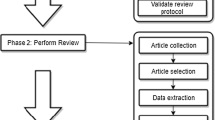Abstract
In recent years various proposals have been offered for increasing the richness of the relational data model by addressing specific user requirements, particularly with regard to structural and behavioral expressiveness. Although there have been some criticisms of the semantic limitations of the model, few proposals have emerged to address them. In this paper we propose an extension of the model to address some of the semantic limitations around the use of multi-face attributes in everyday activity. We present a formal discussion of multi-face attributes and suggest how they can be accommodated in the relational model and relational database software systems. The resulting model offers a higher-level expressiveness and will provide the user with increased flexibility in the input, output and storage of data, and the specification of queries. Finally we outline some of the implications for database design methods that emerge for the extension.
Similar content being viewed by others
References
Adiba M, Delobel C, Leonard M. A unified approach for modeling data in logical data base design. In: Nijssen GM, ed. Modelling in Data Base Management Systems. Amsterdam: North Holland, 1976.
Armstrong WW, Delobel C. Decomposition and functional dependencies in relations. ACM Transactions on Database Systems 1980;5:404–430.
Atkinson M, Bancilhon F, DeWitt D, Dittrich K, Maier D, Zdonik S. The object oriented database systems manifesto. In: Proceedings of the International Conference on Deductive and Object Oriented Databases, Elsevier, Amsterdam, 1990.
Atzeni P, De Antonellis V. Relational Database Theory. New York: Benjamin-Cummings, 1993.
Beeri C. On the membership problem for functional and multivalued dependencies in relational databases. ACM Transactions on Database Systems 1980;5:241–259.
Biller H, Neuhold EJ. Semantics of data bases: The semantics data models. Information Systems 1978;3:11–30.
Brodie ML. The application of data types to database semantic integrity. Information Systems 1980;5:287–296.
Brodie ML. On the Development of Development of Data Models. In: Brodie M, Mylopoulos J, and Schmidt J. eds. On Conceptual Modelling. Berlin: Springer Verlag, 1982.
Cattel R. Object Data Management: Object-Oriented and Extended Relational Database Systems. New York: Addison-Wesley, 1991.
Codd EF. A relational model for large shared data banks. Communications of the ACM 1970;13(6):377–387.
Codd EF. Extending the database relational model to capture more meaning. ACM Transactions on Database Systems 1979;4:397–434.
Codd EF. The Relational Model for Database Management Version 2. New York: Addison-Wesley, 1990.
Cox N, Alfred B, Rhind D. A relational database system and a proposal for a geographic data type. Geo-Processing 1 1979;3:217–229.
Egenhoffer M. Extending SQL for cartographic display. Cartography and Geographic Information Systems 1991;18(4):230–245.
Fagin R. Multivalued dependencies and a new normal form for relation databases. ACM Transactions on Database Systems 1977;2:262–278.
Falkenberg E. Concepts for modelling information. In: Nijssen GM, ed. Modelling in Data Base Management Systems. North Holland, 1976:95–110.
Hammer M, McLeod D. Semantic integrity in a relational database system. In: Proceedings of the 1st. International Conference on Very Large Data Bases 1975:25–47.
Hammer M, McLeod D. Database description with SDM: A semantic data model.ACM Transactions On Database Systems 1981;6(3):351–386.
Koymen K, Cai Q. "SQL*: A recursive SQL. Information systems 1993;18(2):121–128.
Morrissey J. Imprecise information and uncertainty in information systems. ACM Transactions on Information Systems 1990;8(2):159–180.
Saltor F. Semantic relativism in databases: The case of RM/T. Facultat d'Informatica RR 18/87, UPC, Barcelona, 1987.
Saltor F, Garcia-Solaco M. Diversity with cooperation in database schemata: Semantic relativism. In: Proceedings of the Fourteenth International Conference on Information Systems 1993:247–254.
Schmid HA, Swenson JR. On the semantics of the relational model. In: Proceedings of ACM SIGMOD, 1975:211–223.
Tansel C, Jajodia G, Snodgrass S. Temporal Databases: Theory, Design, and Implementation. Benjamin/Cummings, 1993.
Author information
Authors and Affiliations
Rights and permissions
About this article
Cite this article
Osei-Bryson, KM., Ngwenyama, O.K. Supporting Semantic Diversity in the Relational Data Model: The Case of Multi-Face Attributes. Information Systems Frontiers 6, 277–285 (2004). https://doi.org/10.1023/B:ISFI.0000037881.10525.07
Issue Date:
DOI: https://doi.org/10.1023/B:ISFI.0000037881.10525.07




